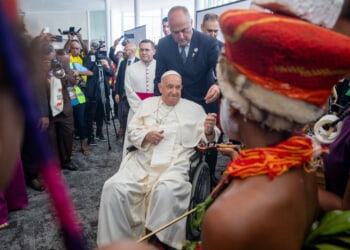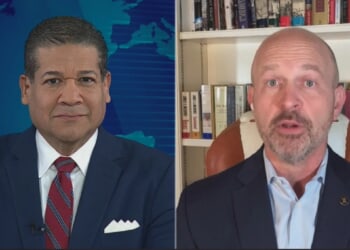NextGen Marxism: What It Is and How to Combat It
By Mike Gonzalez and Katharine Gorka
(Encounter Books, 328 pages, $22)
It is a sad state of affairs that Marxism and socialism have reached new heights of popularity and power in America in recent years. A 2019 survey by the Victims of Communism Memorial Foundation (using YouGov data) revealed that nearly a third of millennials approve of communism. The 2020 survey by Victims of Communism showed that close to 40 percent of Americans generally (of all ages) held a favorable view of socialism, up from 36 percent in 2019. Among Gen Z, those who favor socialism was 49 percent in 2020, up from 40 percent in 2019. The numbers have been on the rise.
Together, the answer provided by these new Marxists was to infiltrate various cultural and educational institutions … to bring about the revolution.
How could this be? Didn’t Americans learn anything from the depravity and death that was brought by those who called themselves Marxists? Today’s rising support for Marxism (as well as socialism) didn’t happen randomly, and the worst part is that these modern Marxists have evolved from their Bolshevik counterparts. They have applied their Marxist thinking to a wider array of oppressed-versus-oppressor issues that go well beyond the classical Marxist concerns of economics and class. There’s a new breed of Marxism.
Despite the growing popularity and strength of this new breed of Marxism, for Mike Gonzalez, the Angeles T. Arredondo E Pluribus Unum Senior Fellow at the Heritage Foundation, and Katharine Cornell Gorka, former presidential appointee in the Office of Policy at the Department of Homeland Security, there is still a chance to turn the tide.
In their latest work, NextGen Marxism: What It Is and How to Combat it, Gonzalez and Gorka provide readers with one of the most comprehensive analyses of today’s Marxism and provide readers with the necessary tools from which they can confront today’s Marxists.
NextGen Marxists’ Origins
Who exactly are these NextGen Marxists and where did they come from? Well, unfortunately, understanding today’s Marxism is not as simple as we might think. Thus, the challenges. Nonetheless, Gorka and Gonzalez take up the task by tracing the historical and philosophical roots of the ideology.
The origins of today’s Marxism, as Gorka and Gonzalez point out, are not uniquely different from those of its ancient predecessors. “Marxism,” they state, “is also just one more in an age-old litany of voices that claim man can create the ideal society here on earth.” The ideas surrounding the creation of a communal society ruled by an enlightened elite, shedding wealth inequality and division, and achieving the perfectibility of man, are as old as the Greek philosopher Plato. Gorka and Gonzalez point out that throughout the ages, the notion of such a communal utopia has been embraced, at least in modified form, by the profound intellectual minds of the likes of Thomas More, Francis Bacon, Jean Jacques Rousseau, and Georg Hegel.
This egalitarian utopianism eventually became the bedrock of Karl Marx’s and Fredrich Engels’ vision of the world. While many socialists of Marx’s time had taken a more subtle approach, Marx and Engels called for the “forcible overthrow of all existing conditions,” as stated explicitly in the concluding paragraphs of their 1848 The Communist Manifesto. As Gorka and Gonzalez note, “Marx and Engels took the revolutionary impetus in a direction that allowed it to be more virulent and more violent.” Not only was this radical approach “the darkest of all the revolutionary programs,” but the atheist Karl Marx also sought to deify himself, making “himself not merely the apostle but the god of his new, destructive religion.”
While Marx’s destructive ideology eventually came to fruition with the success of the Bolshevik Revolution, today’s Marxism wouldn’t originate in Russia. The origins of today’s Marxists are rooted in the soil and toil of revolution in post-World War I Italy and Germany.
It is here that Gorka and Gonzalez thoroughly examine the mind of the influential Marxist Italian thinker, Antonio Gramsci, as well as the German Marxists of the Frankfurt School, including Felix Weil, Max Horkheimer, Karl Korsch, Georg Lukacs, and the most prominent member of them all, Herbert Marcuse. While Gramsci and the Frankfurt School sought to ignite and bring about the proletariat revolution in their respective countries, neither found success. Why did their revolutions fail? Well, for Gramsci and the Frankfurt School, the problem was the workers, whom they believed willfully, though unknowingly, participated in their own oppression by embracing bourgeois morality through society’s cultural institutions.
Gramsci’s famous “Theory of Hegemony” argued that the “subordinate class has imbibed the cultural ideas of the ruling class,” and thus shifted the Marxist focus from violent revolution to infiltrating cultural institutions in order to “awaken” the revolutionary consciousness of the workers. “Gramsci understood the primary lesson of this historic defeat,” Gorka and Gonzalez reveal. “There was a need for painstaking indoctrination of the people years, perhaps decades, before complete transformation was attempted again.”
As for the Frankfurt School, its theorists came to the same observation as Gramsci, namely, that the workers had accepted their oppression that “extended from the factory into the unions and parties, and ultimately into everyday life as well.” Unlike Gramsci, however, Marcuse and his Frankfurt colleagues believed that the primary agent for revolution would be the intellectuals.
Together, the answer provided by these new Marxists was to infiltrate various cultural and educational institutions (churches, colleges, media, etc.) to bring about the revolution. It would be this focus on taking over the “conveyor belts” of culture that Gramsci’s and the Frankfurt School’s observations would become the basis for today’s Marxists. Gramsci’s ideas and tactics effectively turned him into “the communist strategist for countries where revolution was not possible.”
There was also what became known as “critical theory.”
As Gorka and Gonzalez note, the Frankfurt School created critical theory as a method to endlessly critique the ruling order to “make people doubt the old verities and, in time abandon them.” This strain of Marxist thinking has become the prevailing doctrine of today’s NextGen Marxism. It “animated the radicals of the 1960s, and it continues to resonate to our day, a full century later,” say Gorka and Gonzalez. “As its name suggests, critical theory is the forebear of our own CRT, the doctrine of NextGen Marxists.”
Rise of the New Left and Today’s Marxists
Just as Gorka and Gonzalez focus their attention on Gramsci and the Frankfurt School, they spend considerable time tracing the rise of the 1960s New Left and its infiltration into America’s cultural and educational infrastructure.
Though the term “New Left” began in the 1950s in France and Britain, for America “it was popularized by the Marxist sociologist C. Wright Mills, who spent most of his career at Columbia University.” Mills came to America along with Marcuse and other Frankfurt School members. They began the process of radicalizing the youth in their classrooms at Columbia and other institutions by deploying their teachings of critical theory across various subjects that would have never occurred to Marx and Engels, such as race, gender, ethnicity, and more.
Other leftist influences added to the chaos. For instance, the works of Howard Zinn and Saul Alinsky provided further intellectual and practical inspiration on issues ranging from race to environmentalism and anti-colonialism; they pulled in various allies to engage in “community organizing” to “mobilize” the “oppressed” (i.e., minorities, women, youth) against their “oppressors” (i.e., white males, Judeo-Christian religious believers, capitalists).
As time went on, the youth of the New Left would detach themselves from Soviet communism and instead attach themselves to new Marxist nations that they hoped might adhere to their revolutionary vision. In the 1960s, many of these nations were pulling away from colonialism, and thus attractive options for the new Marxists. “The New Left rejected both Moscow and Washington D.C,” Gorka and Gonzalez state, “but it did embrace Cuba, North Vietnam, Algeria, and Mao’s China with passion.”
The key figure that inspired the youth of the New Left was none other than Cuban Marxist dictator Fidel Castro. “In fact, Castro was a major influence in shaping the New Left,” state the authors. Castro was often a coveted speaker for these youth. When he visited Harvard in April 1959, he insisted: “that is where you find the real ‘military spirit:’ in students, not in the barracks.”
Inspired by the works of Gramsci, the Frankfurt School, and Fidel Castro, these radicalized ‘60s youth became the leaders, activists, and influencers that ultimately began to infiltrate, promulgate, and increase the power and popularity of NextGen Marxism. The authors point out that the New Left “abandoned the idea, once and for all, that workers would be the agents of revolutionary change.”
The New Left became more diverse and extended itself with the rise of organizations such as Students for a Democratic Society (SDS). Gorka and Gonzalez state that SDS “metastasized into the terrorists of the Weather Underground (who were, too, part of the New Left); the Student Nonviolent Coordinating Committee (SNCC, pronounced ‘snick’), the black liberation militants and the hippies, the radical feminists and so on.”
The authors thoroughly examine the key figures of the New Left ranging from Tom Hayden of SDS, Bill Ayers and his domestic terrorist colleagues of the Weather Underground, Marcuse’s protege Angela Davis, to the minds of critical race theorist Derrick Bell and Eric Mann. Over time, these figures of the New Left managed to successfully infiltrate into areas of government, media, academia, and the wider culture. Their success came to fruition with their acolytes rising to prominence in American society through political leaders like President Barack Obama, Secretary of State Hillary Clinton, 1619 project author Nikole Hannah-Jones, and Black Lives Matter founders Alicia Garza, Patrisse Cullors, and Opal Tometi.
These proteges of the New Left became key figures in implementing NextGen Marxism in American society, whether through critical race theory, cultural Marxism, transgenderism, ESG, or the violent left-wing activism of the likes of Antifa and BLM. Additionally, the success of NextGen Marxists’ has gone global with the formation of organizations like the World Social Forum, Left Forum, and Foro de Sao Paulo. This has spread the Marxist tentacles to regimes in China, Venezuela, and across Latin America and the Third World.
Confronting the New Red Menace
Despite the successful infiltration of America’s institutions by NextGen Marxists, Gorka and Gonzalez firmly believe that the tide can be turned. Taking inspiration from the ideals of the American founders and even tactics used by the Active Measures Working Group (AMWG) and NSC-68, the authors provide an impressive blueprint for curtailing today’s Marxists. The authors assure readers that saving America will not be easy and will require every one of us to battle to save America and our very freedoms. “There is no army of angels or experts who will fulfill these roles for us,” they note. “It is up to each one of us.”
They offer more than just encouraging words. Using concrete examples, Gorka and Gonzalez illustrate how conservatives have already confronted issues such as CRT, transgenderism, ESG, and Marxist ideology on various fronts that last several years. They have had success in banning the teaching of CRT in many school districts, in prohibiting biological males from women sports, and in following the money and exposing woke corporations and organizations such as BLM. Gorka and Gonzalez also highlight ways that average Americans can get involved with elections, working the polls, and networking and engaging with like-minded allies in their communities.
Gorka and Gonzalez provide a comprehensive analysis of today’s new Marxism and how to confront it. Some of the elements of the book seem slightly dated, and the topics themselves are complex and sometimes difficult to follow. But there is no wasted space in these pages, as each detail serves to provide clarity on the history and strategies used by NextGen Marxists, thus shedding light on how to best confront and counter them.
NextGen Marxism offers an imposing inquiry as to the ins and outs of today’s Marxists. Though Marxism has had a firm grip on key cultural institutions, Americans must have the courage to stand up to the new red menace. This book is a robust guide for doing so.
READ MORE from Hunter Oswald:


![Reality Hits Adam Schiff in San Francisco—It’s Not Pretty for Democrats [WATCH]](https://www.right2024.com/wp-content/uploads/2025/04/Reality-Hits-Adam-Schiff-in-San-Francisco—Its-Not-Pretty-for-350x250.jpg)



![Trump’s White House Trolls Illegal Alien Gangs With Hilariously Brutal Video [WATCH]](https://www.right2024.com/wp-content/uploads/2025/03/1742261427_Trumps-White-House-Trolls-Illegal-Alien-Gangs-With-Hilariously-Brutal-350x250.jpg)




![James Comer Hints at the Epic Behind-the-Scenes Effort Targeting the Deep State [WATCH]](https://www.right2024.com/wp-content/uploads/2025/04/James-Comer-Hints-at-the-Epic-Behind-the-Scenes-Effort-Targeting-the-350x250.jpg)





